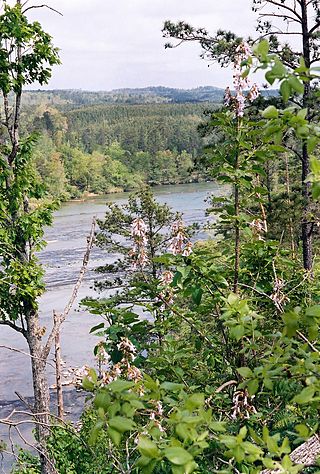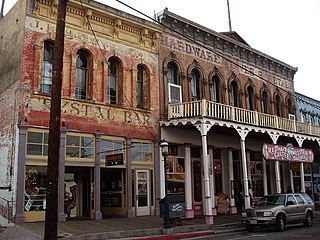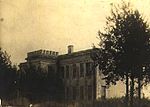
Dallas County is a county located in the central part of the U.S. state of Alabama. As of the 2020 census, its population was 38,462. The county seat is Selma. Its name is in honor of United States Secretary of the Treasury Alexander J. Dallas, who served from 1814 to 1816.

Centreville is a city in Bibb County, Alabama, United States. At the 2020 census, the population was 2,800. The city is the county seat of Bibb County.

Columbia is a town in Houston County, Alabama, United States. It is part of the Dothan, Alabama Metropolitan Statistical Area. At the 2010 census the population was 740, down from 804 in 2000.

Nicodemus National Historic Site, located in Nicodemus, Kansas, United States, preserves, protects and interprets the only remaining western town established by African Americans during the Reconstruction Period following the American Civil War. The town of Nicodemus is symbolic of the pioneer spirit of African Americans who dared to leave the only region they had been familiar with to seek personal freedom and the opportunity to develop their talents and capabilities. The site was named, at least in part, for a legendary African-American slave featured in abolitionist Henry Clay Work's "Wake, Nicodemus (1864)." It is a mystical story of an old slave died away and buried in a hollow tree who had asked to be awakened on the Day of Jubilee.

The Cahaba River is the longest substantially free-flowing river in Alabama and is among the most scenic and biologically diverse rivers in the United States. It is a major tributary of the Alabama River and part of the larger Mobile River basin. With headwaters near Birmingham, the Cahaba flows southwest, then at Heiberger turns southeast and joins the Alabama River at the ghost town and former Alabama capital of Cahaba in Dallas County. Entirely within central Alabama, the Cahaba River is 194 miles (312 km) long and drains an area of 1,870 square miles (4,800 km2). The name Cahaba is derived from the Choctaw words oka meaning "water" and aba meaning "above"

Cahaba Prison, also known as Castle Morgan, held prisoners of war in Dallas County, Alabama where the Confederacy held captive Union soldiers during the American Civil War. The prison was located in the small Alabama town of Cahaba, at the confluence of the Alabama and Cahaba rivers, not far from Selma. It suffered a serious flood in 1865. At the time, Cahaba was still the county seat, but that was moved to Selma in 1866. Cahaba Prison was known for having one of the lowest death rates of any Civil War prison camp mainly because of the humane treatment from the Confederate commandant.

Virginia City Historic District is a National Historic Landmark District encompassing the former mining villages of Virginia City and Gold Hill, both in Storey County, as well as Dayton and Silver City, both to the south in adjacent Lyon County, Nevada, United States. Declared a National Historic Landmark in 1961, the district is one of only six in the state of Nevada.

St. Luke's Episcopal Church is a historic Carpenter Gothic church, built during the 1850s at Cahaba, the first capital of Alabama from 1820 to 1826. The unknown builder closely followed plans published by architect Richard Upjohn in his 1852 book Rural Architecture.
Browns is an unincorporated community in Dallas County, Alabama. Browns formerly had one site included on the National Register of Historic Places, St. Luke's Episcopal Church, before it was removed to Cahaba in 2006. It is home to a community airport.

Prairie Bluff, also known as Dale and Daletown, is a ghost town in Wilcox County, Alabama.

Sturdivant Hall, also known as the Watts-Parkman-Gillman Home, is a historic Greek Revival mansion and house museum in Selma, Alabama, United States. Completed in 1856, it was designed by Thomas Helm Lee for Colonel Edward T. Watts. It was added to the National Register of Historic Places on January 18, 1973, due to its architectural significance. Edward Vason Jones, known for his architectural work on the interiors at the White House during the 1960s and 70s, called it one of the finest Greek Revival antebellum mansions in the Southeast.

The Joseph T. Smitherman Historic Building, also known by a variety of other names throughout its history, is a historic Greek Revival building in Selma, Alabama. Completed in 1847, it has served many functions in the more than 160 years of its existence. The building was added to the National Register of Historic Places on June 20, 1975, due to its architectural and historical significance. It currently houses the Vaughan-Smitherman Museum, a museum depicting Selma's history.

The Brierfield Furnace, also known as the Bibb Naval Furnace and Brierfield Ironworks, is a historic district in Brierfield, Alabama, encompassed by Brierfield Ironworks Historical State Park. The district covers 486 acres (197 ha) and includes one building and nine sites. It was listed on the National Register of Historic Places on November 20, 1974.

The John Tyler Morgan House is a historic Greek Revival-style house in Selma, Alabama, United States. It was built by Thomas R. Wetmore in 1859 and sold to John Tyler Morgan in 1865. Morgan was an attorney and former Confederate general. Beginning in 1876, he was elected as a Democratic U.S. senator from Alabama for six terms. He used this house as his primary residence for many of those years.

Elm Bluff is a historic former forced-labor farm and plantation house in the rural community of Elm Bluff, Dallas County, Alabama, United States. Situated on a bluff high above the Alabama River, the now near-ruinous house is considered by architectural historians to be one of the most refined and unusual Greek Revival-style houses in the state.

Edward Martineau Perine was a merchant and planter in Cahaba, Alabama. Born at Southfield, Staten Island, New York, a son of Edward and Addra Guyon Perine, and a descendant of Daniel Perrin, "the Huguenot", Perine moved to Cahaba, Alabama, in the early 1830s, where he became a wealthy merchant and plantation owner. As early as 1832, Perine entered business as a partner with Thomas Moreng and Richard Conner Crocheron in the firm of Thomas Moreng and Company. Following Moreng's death in 1835, the business was dissolved and replaced by the partnership of Perine and Crocheron. Their store was located on the corner of Vine and Second North Streets in Cahaba, directly opposite Bell's Hotel. In 1850 Perine bought Crocheron's interest in the business and the storehouse and in 1853 Perine sold his mercantile establishment to the partnership of Samuel M. Hill and John R. Sommerville. In 1856, he was once again in business, this time in partnership with Sommerville in the firm of E. M. Perine and Company. The partnership dissolved in 1858, with Sommerville continuing as a salesman for E. M. Perine and Company. In 1860 Perine was in partnership again, this time as Perine and Hunter. Anna M. Gayle Fry, writing in her book Memories of Old Cahaba, describes E. M. Perine as "a merchant prince of ante-bellum days, a Northern gentleman of the old school who was universally beloved by all who knew him." Following the Civil War, Perine's business at Cahaba was ruined, as his daughter Mary E. Perine Tucker put it, having "lost all".

The Lowndesboro Historic District is a historic district in Lowndesboro, Alabama, United States. It was placed on the National Register of Historic Places on December 12, 1973. The district covers 1,800 acres (730 ha), spread over the entire town, and contains 20 contributing properties, including Meadowlawn Plantation. Architectural styles include the Gothic Revival, Greek Revival, and other Victorian styles.

The Wesley Plattenburg House is a historic house in Selma, Alabama. Featuring a unique combination of the Greek Revival and Italianate styles, it was completed in 1842 for Wesley Plattenburg. Plattenburg was born on April 13, 1803, in Anne Arundel County, Maryland. He had relocated to Selma and had assumed the occupation of tailor by 1829. He became a successful merchant and served on the city council of Selma for many years.

The Summerfield District is a 56.2-acre (22.7 ha) historic district in Summerfield, Dallas County, Alabama. It is bounded by the Selma-Summerfield and Marion roads, and Centenary and College streets. Federal and Greek Revival are the primary architectural styles in the district. It contains 10 contributing properties and 6 noncontributing properties. The contributing properties are the Summerfield Methodist Church (1845), Summerfield Bank Building, school, Moore-Pinson-Tate-Hudson House (1840s), Sturdivant-Moore-Caine-Hodo House, Johnson-Chisolm-Reed House, unnamed residence, Bishop Andrew-Brady House, Swift-Moore-Cottingham House, and Childers-Tate-Crow House. The Summerfield District was added to the National Register of Historic Places on March 1, 1982.































